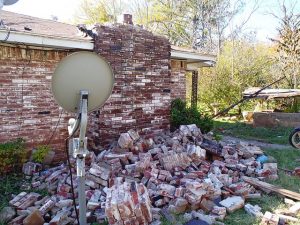19 April 2017-DENVER — In 2016, a spate of earthquakes in Oklahoma resulted in significant damage to homes and businesses, occurring as part of an unprecedented increase in the regional earthquake rate that is likely caused by an increase in wastewater injection from oil and gas production.

Earthquakes such as the February 2016 magnitude 5.1 Fairview quake, November 2016’s 5.0 Cushing quake, and the September 2016 5.8 Pawnee quake — the state’s largest in historic times — have made Oklahoma a laboratory for studying human-induced seismicity, according to researchers gathered at the 2017 SSA Annual meeting.
In many cases, these earthquakes have been studied with the help of new seismic stations deployed by the Oklahoma Geological Survey and others throughout the state that give seismologists a better look at fore-and aftershocks and earthquake sequences, University of Oklahoma researcher Nori Nakata and colleagues reported at the meeting.
The 2016 Fairview, Pawnee and Cushing earthquakes all appear to be the result of wastewater injection, with some key differences in their sequences and timing related to changes in injection rate that Arthur McGarr of the U.S.Geological Society and colleagues discussed at SSA. In particular, the researchers suggested that a magnitude 5.7 earthquake near the Cushing area cannot be ruled out, based on the large volume of injected fluid — about 14.5 million cubic meters so far — in a region that has already seen faults reactivated by injection.
USGS researcher William Yeck and colleagues discussed how the combination of inconsistent foreshock activity among these three earthquakes, which occurred on previously unmapped faults and in some cases at large distances (more than 10 kilometers or 6.2 miles) away from high-rate injection sites, can make it more difficult to determine how to mitigate induced earthquakes. In a presentation by Katie Keranen of Cornell University and colleagues, the researchers discussed how the 2016 Pawnee earthquake occurred across a series of unmapped smaller “hidden” fault segments that ruptured as the result of injection-related pore pressure changes.
One aspect of induced seismicity being studied in Oklahoma is the mechanisms by which wastewater injection can cause earthquakes, as these disposal fluids alter the pressure on pores and fractures in rock or relax rock stress in other areas. In their SSA presentation, Thomas Göebel of the University of California, Santa Cruz and colleagues described the kinds of triggering mechanisms at work in the greater Fairview area of Oklahoma, concluding that there is a possibility for long-range triggering of earthquake clusters occurring 40 to 50 kilometers away from wastewater injection sites.
In another presentation, Will Levandowski of the U.S. Geological Survey and colleagues discussed their research on the pressure required to induce fault slip in rock with geomechanical properties like those found in northern Oklahoma. Their calculations that injection pressures are usually equal to or greater than the pressure needed to cause fault slip in about 45 percent of all mapped faults lying about three kilometers (1.86 miles) under the surface. The researchers suggest that earthquake hazards may be minimized by putting some distance between subsurface injection sites and this underpressured basement rock layer.
